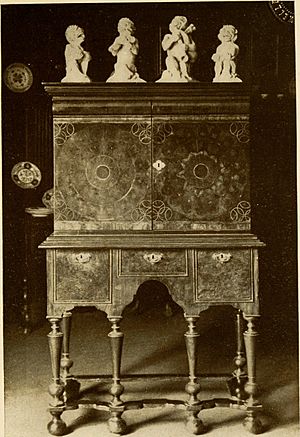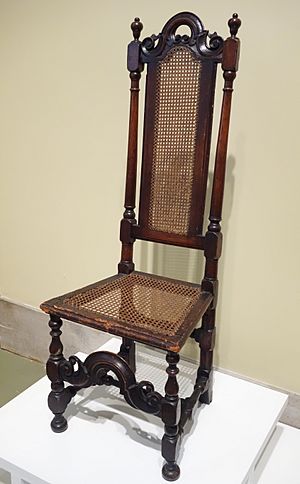William and Mary style facts for kids
The William and Mary style is a type of furniture design. It was popular between 1700 and 1725. You could find it in the Netherlands, Kingdom of England, Kingdom of Scotland, and Kingdom of Ireland. Later, it also became popular in England's American colonies. This style was a bridge between older designs and the newer Queen Anne furniture. William and Mary furniture was strong and sturdy. It often had both straight lines and curves. You would see fancy carvings and woodturning on it. It was also one of the first styles to use ideas from Asian designs, like japanning.
Contents
Discovering the William and Mary Furniture Style
In 1688, James II of England was removed from his throne. His daughter, Mary, and her husband, William of Orange, took over. This event is known as the "Glorious Revolution". William had been a ruler in the Dutch Republic since he was born in 1650. Mary lived in the Netherlands with him after they married in 1677.
When William and Mary became rulers, they brought their love for Dutch furniture styles to England. They also brought many Dutch furniture makers with them. The William and Mary style started to form even before they ruled. This was partly because of King Charles II's wife, Catherine of Braganza, who was from Portugal. But the style really became popular during William and Mary's time. It was named after them.
Key Features of the Design
The William and Mary furniture style was influenced by French furniture designs. These French designs had been inspired by Italian Baroque furniture. The William and Mary style focused on making all parts of a piece work together. This created a unified look.
Furniture in this style often had detailed carvings that stood out. It also featured strong curves and fancy woodturning. Even with these decorations, the furniture looked solid and heavy. Straight lines were very common. Makers used paint, stains, or different kinds of wood. This created contrasting colors, which was a key part of the style. Japanning, a popular way to varnish furniture, was also used.
For chairs, people often used seats made of woven cane. The backs of the chairs were often heavily curved. Later, leather seats became more common. The curved backs also changed to straighter or slightly angled shapes.
The William and Mary style also influenced other art forms. This included buildings, pottery, silver, and fabrics. This design movement greatly improved the quality of British furniture. It was very popular in Britain from 1700 to 1725. In America, it lasted until about 1735. After that, the Queen Anne style furniture largely took its place.
English Furniture Variations
Daniel Marot, a French designer, worked for King William and Queen Mary. He greatly influenced furniture in England, Scotland, and Wales. Another Dutch craftsman, Gerrit Jensen, became the royal Cabinet Maker. Many of his designs were bought by rich British citizens.
In Britain, large pieces of furniture like cabinets often had simple flat surfaces. But they featured beautifully carved edges. Furniture makers in the countryside started using wooden seats covered in leather. This was a local design. Split spindles also became popular. They were first used in rural areas, then in cities.
The daybed was created in Britain as part of this style. The writing desk also came about. It was a new version of the bureau-cabinet.
American Furniture Variations
American furniture makers who used the William and Mary style liked a tapered, curved foot for their designs. They mostly used walnut wood, and some maple. Walnut burl veneers were common. They also used "ebonization," which made the wood look black with japanning.
Over time, American William and Mary furniture became simpler. The fancy Baroque style was still seen in some parts, like the tops, feet, and curves. But other parts of the furniture started to look plainer. American chairmakers also began using woven cane in the middle back supports, called splats. For armchairs, American designers preferred seats and splats covered in leather. These were often held on with brass nails.
In places like New York and New Jersey, which had a strong Dutch influence, the kast became popular. A kast was a large Dutch cabinet. It had a big drawer at the bottom. Above that were shelves hidden behind one or two heavy doors. A fancy top edge, called a cornice, was usually at the very top. American kasts influenced by the William and Mary style had feet that could be removed. Their cornices were simpler, and they didn't have the fancy inlays that Dutch ones did.
The "Boston chair" was a famous American example of the William and Mary style. This chair had a curved back and a leather-covered seat and splat. Its front legs and the bar between them were turned (shaped on a lathe). But the side and back bars, and the back legs, were plain and straight. The corners of the frame around the splat were usually rounded. The top of the back was a simple geometric or curved design. These chairs were often painted black or red. They were made in large numbers in Boston, Massachusetts, and were very popular. They were even sent to Britain. Benches and settees made in America were less influenced by this style. They often used flat panels for the seat, back, and arms. Their legs and trim showed the new style. Sometimes, leather seats were added.
Another new piece of furniture was the highboy. This was basically two chests of drawers stacked on top of each other. The bottom chest was a bit larger. American highboys often had twisted or trumpet-shaped legs. The front of the drawers sometimes had a walnut burl veneer.
The William and Mary style lasted in rural America even past the mid-1700s. It often mixed ideas from older and newer styles. Slats began to be used in chair backs. Also, yoke-shaped tops became common.
Modern Popularity of the Style
The William and Mary style is not as well-known today as the styles that came after it. You won't find many new copies of this furniture. However, you can still find many original William and Mary style pieces in older homes in the British countryside.



